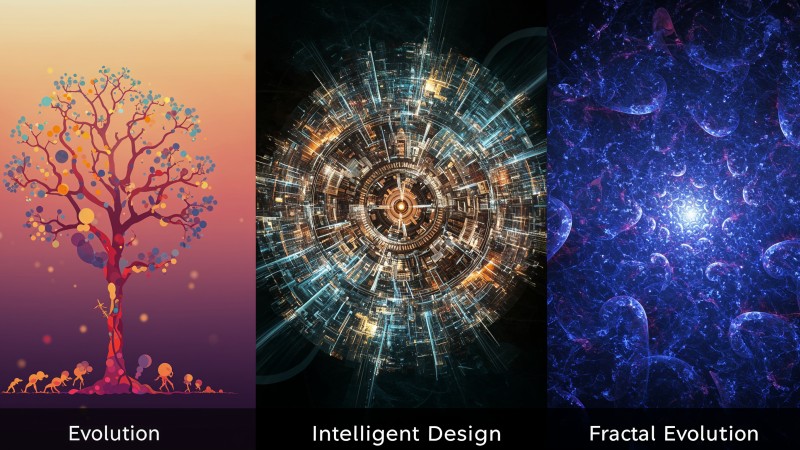Fractal Evolution: Understanding Life's Development Through Patterns

Introduction It’s not evolution versus intelligent design. It never truly was.
Let’s begin with the materialist view. In this perspective, life is the result of random mutations filtered by natural selection. There's no direction—just the statistical survival of genes that improve reproductive success. Over time, complexity emerges through cumulative changes, like a vast biological lottery slowly stacking the odds in favor of adaptability.
Next, consider the intelligent design view, often likened to a divine watchmaker who forged the universe in a single act of complete intention. Everything, from atoms to ecosystems, was either fully created or guided with a purpose from the start. In this view, life was designed, not discovered.
But what if there's a third perspective—a fractal view? One where life unfolds through a guided process, step by step, layer by layer. A universe not assembled all at once, nor driven purely by randomness, but by patterns—self-similar processes that build complexity through recursive, adaptive steps. Here, trial and error are not blind—they are the tools of a deeper order. The design is the process.
In this fractal view, evolution mirrors the development of a multicellular organism—such as a human. Just as an embryo unfolds from a single cell into a complex being through structured stages, so too has life on Earth progressed in a stepwise, patterned fashion. The emergence of form, function, and consciousness is not purely random—it follows developmental rhythms that scale across time and complexity.
1. Evolution and Development: Two Sides of the Same Coin?
Development follows a roadmap. From a single cell, a complex being unfolds through predictable, recursive stages. Evolution, too, might be seen as a developmental journey—one that occurs on a planetary scale. In this view, the emergence of life, complexity, and consciousness follows self-similar stages: from atoms to cells, to multicellular life, to ecosystems, to intelligent beings.
The biosphere mirrors the development of a mammal—stage by stage, system by system.
1. The First Cell
Biosphere Development: Life began with a single-celled organism—likely a prokaryote capable of self-replication, nutrient absorption, and adaptation.
Multicellular Development: Every mammal begins as a single fertilized egg (zygote), containing the full blueprint to create a complex organism.
Fractal Insight: Life at all scales begins with a single unit capable of self-organization and replication.2. Digestion Comes First
Biosphere Development: Bacteria, some of the earliest life forms, dominated Earth's ecosystems and served as the biosphere's digestive system—breaking down organic matter and recycling nutrients.
Multicellular Development: One of the first major events in embryonic development is gastrulation, which leads to the formation of the primitive gut.
Fractal Insight: Systems for breaking down and processing matter emerge early, whether in the biosphere or the body.3. Photosynthesis and Respiration
Biosphere Development: The rise of photosynthetic organisms like cyanobacteria transformed Earth's atmosphere, producing oxygen and enabling aerobic life. This shift paved the way for complex respiration-based organisms.
Multicellular Development: The lungs form to exchange gases in an oxygen-rich environment. Though one of the last systems to become functional, their formation is essential for survival after birth.
Fractal Insight: Mastering gases—through photosynthesis or respiration—marks a leap in complexity.4. Control and Regulation
Biosphere Development: The biosphere evolved toward homeostasis through the Gaia Hypothesis—life stabilizing climate, atmosphere, and resources via feedback loops.
Multicellular Development: The endocrine system and brain emerge to regulate internal functions, maintaining balance across organs.
Fractal Insight: Feedback regulation is the mind of the system—coordinating and adapting through integrated control.5. Consciousness and Emergence
Biosphere Development: Consciousness emerged late—humans only recently began reflecting on their place in the cosmos, showing abstract thought and moral reasoning.
Multicellular Development: The human brain, especially the prefrontal cortex, is one of the last regions to fully develop, continuing well into early adulthood.
Fractal Insight: Consciousness is the final expression of integrated complexity—the last to emerge, but the first to wonder why.
2. Fractals in Biology: Nature’s Signature
Fractals are patterns that repeat at different scales. They're visible in rivers, trees, lungs, neurons, and even galaxy clusters. If evolution is a system, then fractals might be the blueprint. Life doesn’t just evolve randomly—it unfolds recursively, like branches on a tree or spirals in a shell. Evolution mirrors itself across scales: the branching of blood vessels resembles tree roots, and slime molds mimic neural structures so closely that their growth visually mirrors the branching networks of the human brain.
3. Systems Thinking and Feedback Loops
Like development, evolution works within systems of feedback. Genes interact with environments. Organisms shape ecosystems, which in turn shape organisms. These interactions create loops that stabilize, accelerate, or redirect evolution. Evolution is not just survival of the fittest—it's adaptation within a dynamic, changing, interconnected web.
4. Modularity and Reuse in Evolution
In embryology, modular building blocks like Hox genes guide development. These same genes show up across species, reused and repurposed. Evolution doesn't start from scratch—it modifies existing modules. This fractal reuse of genetic and developmental code mirrors how software developers use libraries or how branches repeat along a tree.
5. Entropy, Equilibrium, and the Drive Toward Complexity
Entropy doesn’t just create disorder—it drives systems toward equilibrium. In biology, this can lead to greater complexity and stability. Evolution may be a manifestation of entropy seeking balance through structured, self-organizing systems. Development and evolution both harness entropy—not as a destroyer, but as a harmonizer.
Conclusion: A Fractal Lens on Evolution
If we view evolution not as a blind walk through genetic variation, but as a recursive, self-similar developmental journey, we begin to see it differently. Life evolves like it develops—through stages, feedback, and patterns. This view doesn’t reject Darwin but expands upon him. Just as a seed holds the form of the tree, the early ingredients of life may have contained the fractal algorithm for consciousness itself.
Closing Thought
Perhaps we are not separate from the process—we are the latest unfolding of it. Evolution is not behind us; it is still occurring, through us, and ahead of us.


Leave a comment